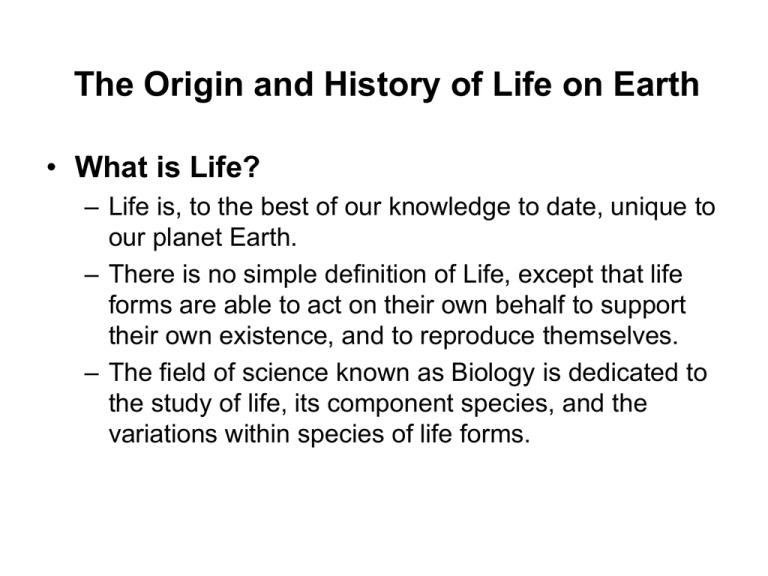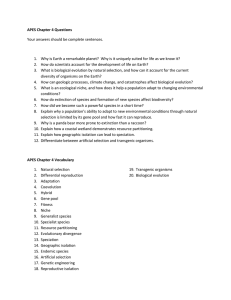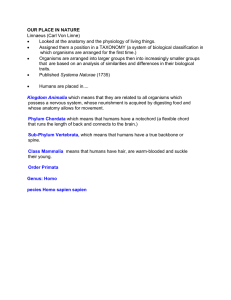The Origin and History of Life on Earth What is Life?
advertisement

The Origin and History of Life on Earth • What is Life? – Life is, to the best of our knowledge to date, unique to our planet Earth. – There is no simple definition of Life, except that life forms are able to act on their own behalf to support their own existence, and to reproduce themselves. – The field of science known as Biology is dedicated to the study of life, its component species, and the variations within species of life forms. The Origin and History of Life on Earth • What Is a Species? – – – – Species Are Groups of Interbreeding Populations Appearance Can Be Misleading Allopatric and sympatric speciation Geographic Separation of a Population Can Lead to Allopatric Speciation – Ecological Isolation of a Population Can Lead to Sympatric Speciation Earth’s Biosphere and Life Science • Our Earth is, to the best of our current knowledge, the only planet in our Solar System (or beyond) which supports life of any kind. • The time table and processes of the origin of life is poorly known at present, but there is evidence that the simplest forms of life came into being more than 3 billion years ago (out of the total of 4.6 billion years our Earth has been in existence). • Earth’s original atmosphere contained little or no molecular oxygen, which is required by current animal and advanced plant life forms. Earth’s Biosphere and Life Science • The oxygen currently in our atmosphere is produced by green plant photosynthesis, which began with reduction of carbon dioxide by anaerobic bacteria, also known as cyanobacteria or “blue-green algae”, inhabiting the oceans in Earth’s early history. • Animal life, as we know it (which requires atmospheric oxygen), did not come into existence until about 600 million years ago. • An important topic of the present day is that humans are returning CO2 to the atmosphere at a faster rate than plants can reduce it to form O2, which can cause global warming. Evolution of Oxygen Content of Earth’s Atmosphere How Do New Species Form? • Changes in Chromosome Number Can Lead to Sympatric Speciation – Speciation by polyploidy • Change Over Time Within a Species Can Cause Apparent “Speciation” in the Fossil Record • Under Some Conditions, Many New Species May Arise Need Text Description How Is Reproductive Isolation Between Species Maintained? • Premating Isolating Mechanisms Prevent Mating Between Species – Members of Different Species May Be Prevented from Meeting – Different Species May Occupy Different Habitats (Ecological isolation) • Different Species May Breed at Different Times (Temporal Isolation) • Different Species May Have Different Courtship Rituals – Species’ Differing Sexual Organs May Foil Mating Attempts • Postmating Isolating Mechanisms Limit Hybrid Offspring – One Species’ Sperm May Fail To Fertilize Another Species’ Eggs – Hybrid Offspring May Survive Poorly – Hybrid Offspring May Be Infertile What Causes Extinction? • Localized Distribution and Overspecialization make Species Vulnerable in Changing Environments • Very localized distribution can endanger a species • Extreme specialization places species at risk • Interactions with Other Organisms May Drive a Species to Extinction • Habitat Change and Destruction Are the Leading Causes of Extinction • Natural events, of geological or extraterrestrial origin, can cause sudden, and extremely catastrophic, extinctions on a large, or even global, basis. How Did Life Begin? • Experiments Refuted Spontaneous Generation • Chemical Evolution Preceded and Gave Rise to Life – Organic Molecules Can Form Spontaneously Under Prebiotic Conditions – Organic Molecules Probably Accumulated Under Prebiotic Conditions – Organic Molecules May Have Become Concentrated in Tidal Pools • RNA May Have Been the First Self-Reproducing Molecule • Membrane-Like Microspheres May Have Enclosed Ribozymes Broth Heated to Boiling to Sterilize No growth Growth (Broth cooled without exposure to room air) (Broth cooled and exposed to room air) Louis Pasteur's experiment disproving the spontaneous generation of microorganisms in broth. Experimental Research on the Origin of Life • One of the greatest unsolved mysteries of science is, “how did life evolve on Earth?” • We have evidence that the oldest and simplest forms of life, anaerobic bacteria, may have formed more than 3.6 billion years ago (only 1 billion years after Earth was created). • These life forms, also called cyanobacteria or “bluegreen algae”, did not require oxygen to breathe (as do nearly all organisms inhabiting Earth at the present time). Experimental Research on the Origin of Life • However, the capability of these anaerobic bacteria to convert atmospheric carbon dioxide (CO2) into oxygen (O2) and carbohydrates made possible the evolution of more complex life forms, including all animal life, that breathe oxygen and feed upon plant carbohydrates. • Since we have very few geologic records of the earliest periods of life on Earth, scientists have performed laboratory experiments with electric discharges (simulating lightning) in various mixtures of gases (simulating Earth’s earliest atmosphere) to see if the chemical substances required for life forms could have been produced by lightning early in Earth’s history. The Experimental Apparatus of Stanley Miller and Harold Urey • Life's earliest stages left no fossils, so evolutionary historians have pursued a strategy of re-creating in the laboratory the conditions that may have prevailed on early Earth. • The mixture of gases in the spark chamber simulates lightning in Earth's early atmosphere. Did Microspheres Enclose the Earliest Cells? • Cell-like microspheres can be formed by agitating proteins and lipids in a liquid medium. Each microsphere in this photo is about 5 micrometers (µm) in diameter. What Were the Earliest Organisms Like? • The First Organisms Were Anaerobic Prokaryotes • Some Organisms Evolved the Ability to Capture the Sun’s Energy • Photosynthesis Increased the Amount of Oxygen in the Atmosphere • Aerobic Metabolism Arose in Response to the Oxygen Crisis • Some Organisms Acquired Membrane-Enclosed Organelles – Mitochondria and Chloroplasts May Have Arisen from Engulfed Bacteria – Evidence for the Endosymbiont Hypothesis Is Strong The Relationship between Time and the Decay of Radioactive 40K (yellow) to 40Ar (blue) The Probable Origin of Mitochondria and Chloroplasts in Eukaryotic Cells Symbiosis Within a Modern Cell • The ancestors of the chloroplasts in today's plant cells may have resembled Chlorella, the green, photosynthetic, single-celled algae living symbiotically within the cytoplasm of the Paramecium pictured here. What Were the Earliest Multicellular Organisms Like? • Some Algae Became Multicellular – Higher organisms with differentiated cells evolved more than 1 billion years ago • Animal Diversity Arose in the Precambrian Era – Original animal forms were primarily aquatic shelled invertebrates (ocean dwellers), dating back to the Proterozoic (pre-Cambrian) era, more than 600 million years ago. • Life Invaded the Land beginning in the Cambrian Era – Land plants began in the Cambrian era, about 500 million years ago – Oxygen content of the atmosphere reached near-current levels in the Devonian era, beginning nearly 400 million years ago – Land animals date back to the Devonian era, about 350 million years ago. Diversity of Ocean Life during the Silurian Period • (a) Life characteristic of the oceans during the Silurian period, 440 million to 410 million years ago. Among the most common fossils from that time are (b) trilobites and their predators, such as nautiloids and (c) ammonites. This (d) living Nautilus is very similar in structure to the Silurian nautiloids, showing that a successful body plan may exist virtually unchanged for hundreds of millions of years. How Did Life Invade the Land? •Some Plants Became Adapted to Life on Dry Land •Primitive Land Plants Retained Swimming Sperm and Required Water to Reproduce •Seed Plants Encased Sperm in Pollen Grains •Flowering Plants Enticed Animals to Carry Pollen •Some Animals Became Adapted to Life on Dry Land •Amphibians Evolved from Lobefin Fishes •Reptiles Evolved from Amphibians •Reptiles Gave Rise to Both Birds and Mammals A Fish that Walks on Land • Some modern fishes, such as this mudskipper, walk on land. Like the ancient lobefin fishes that gave rise to amphibians, mudskippers use their strong pectoral fins to move across dry areas in their swampy habitats. What Role Has Extinction Played in the History of Life? • Evolutionary History Has Been Marked by Periodic Mass Extinctions • Climate Change Contributed to Mass Extinctions • Catastrophic Events May Have Caused the Worst Mass Extinctions • The extinction of the Dinosaurs has recently been determined to have been caused by an asteroid impact with the Earth about 65 million years ago • There is evidence of an even more catastrophic extinction event further back in Earth’s history (about 300 million years ago) Continental Drift from Plate Tectonics • The continents are passengers on plates moving on Earth's surface as a result of plate tectonics. • (a) About 340 million years ago, much of what is now North America was positioned at the equator. • (b) All the plates eventually fused together into one gigantic landmass, which geologists call Pangaea. • (c) Gradually Pangaea broke up into Laurasia and Gondwanaland, which itself eventually broke up into West and East Gondwana. • (d) Further plate motion eventually resulted in the modern positions of the continents. Evolution of the Earth with Time: Continental Drift 200 Million Years Ago 50 Million Years Ago 150 Million Years Ago 100 Million Years Ago Present How Did Humans Evolve? • Some Early Primate Adaptations for Life in Trees Were Inherited by Humans • Binocular Vision Provided Early Primates with Accurate Depth Perception • Early Primates Had Grasping Hands • A Large Brain Facilitated Hand–Eye Coordination and Complex Social Interactions • The Oldest Hominid Fossils Are from Africa How Did Humans Evolve? • The Earliest Australopithecines Could Stand and Walk Upright • Several Species of Australopithecus Emerged in Africa • The Genus Homo Diverged from the Australopithecines 2.5 Million Years Ago • The Evolution of Homo Was Accompanied by Advances in Tool Technology • Neanderthals Had Large Brains and Excellent Tools How Did Humans Evolve? • Modern Humans Emerged Only 150,000 Years Ago • Cro-Magnons and Neanderthals Lived Side by Side • Several Waves of Hominids Emigrated from AfricaThe Evolutionary Origin of Large Brains May Be Related to Meat Consumption • The Evolutionary Origin of Human Behavior Is Highly Speculative • The Cultural Evolution of Humans Now Far Outpaces Biological Evolution Representative Primates • The (a) tarsier, (b) lemur, and (c) lion-tail macaque monkey all have relatively flat faces, with forward-looking eyes providing binocular vision. All also have color vision and grasping hands. These features, retained from the earliest primates, are shared by humans. The earliest hominid • This nearly complete skull of Sahelanthropus tchadensis, which is more than 6 million years old, is the oldest hominid fossil yet found. Representative hominid tools • (a) Homo habilis produced only fairly crude chopping tools called hand axes, usually unchipped on one end to hold in the hand. (b) Homo ergaster manufactured tools that were typically sharp all the way around the stone; at least some of these blades were probably tied to spears rather than held in the hand. (c) Neanderthal tools were works of art, with extremely sharp edges made by flaking off tiny bits of stone. In comparing these weapons, note the progressive increase in the number of flakes taken off the blades and the corresponding decrease in flake size. Smaller, more numerous flakes produce a sharper blade and suggest either more insight into tool making, more patience, finer control of hand movements, or perhaps all three. Paleolithic Burial • This 24,000-year-old grave shows evidence that CroMagnon people ritualistically buried their dead. • The body was covered with a dye known as red ocher, then buried wearing a headdress made of snail shells and with a flint tool in its hand. Competing Hypotheses for the Evolution of Homo Sapiens • The "multiregional" hypothesis suggests that populations of H. sapiens evolved in many regions simultaneously from the already widespread populations of H. erectus.







